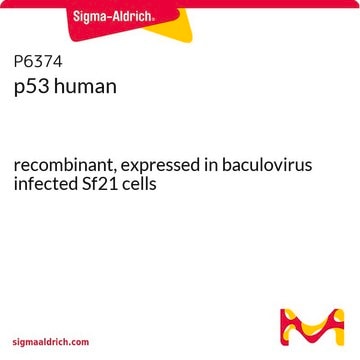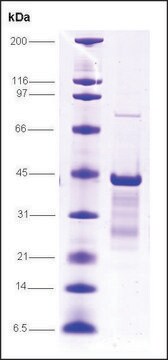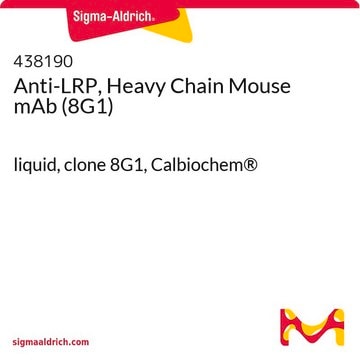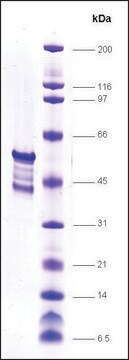SRP2077
p53 (1-363) C-terminal deletion human
recombinant, expressed in insect cells, ≥80% (SDS-PAGE)
Sinónimos:
FLJ92943, LFS1, P53, TRP53
Iniciar sesiónpara Ver la Fijación de precios por contrato y de la organización
About This Item
UNSPSC Code:
12352200
NACRES:
NA.26
Productos recomendados
biological source
human
recombinant
expressed in insect cells
assay
≥80% (SDS-PAGE)
form
frozen liquid
mol wt
~41.8 kDa
packaging
pkg of 5 μg
concentration
850 μg/mL
color
clear colorless
NCBI accession no.
UniProt accession no.
shipped in
dry ice
storage temp.
−70°C
Gene Information
human ... TP53(7157)
Biochem/physiol Actions
Human p53 protein is composed of 393 amino acid residues with several distinct regions. The N-terminal activation domain allows p53 protein to recruit the basal transcription machinery and activate the expression of target genes, whereas the core domain binds to target DNA in a sequence-specific manner and the majority of mutations found in human tumors occur in the region of the gene encoding this domain. The C-terminal domain is composed of predominantly basic residues and modification of the C-terminal basic domain, including acetylation, glycosylation and phosphorylation, is an essential mechanism for regulating p53 function.
Physical form
Clear and colorless frozen liquid solution
Preparation Note
Use a manual defrost freezer and avoid repeated freeze-thaw cycles. While working, please keep sample on ice.
Storage Class
10 - Combustible liquids
wgk_germany
WGK 1
flash_point_f
Not applicable
flash_point_c
Not applicable
Certificados de análisis (COA)
Busque Certificados de análisis (COA) introduciendo el número de lote del producto. Los números de lote se encuentran en la etiqueta del producto después de las palabras «Lot» o «Batch»
¿Ya tiene este producto?
Encuentre la documentación para los productos que ha comprado recientemente en la Biblioteca de documentos.
X Chen et al.
Genes & development, 10(19), 2438-2451 (1996-10-01)
It is well established that induction of the p53 tumor suppressor protein in cells can lead to either cell cycle arrest or apoptosis. To further understand features of p53 that contribute to these cell responses several p53-null Saos2 and H1299
M Hollstein et al.
Science (New York, N.Y.), 253(5015), 49-53 (1991-07-05)
Mutations in the evolutionarily conserved codons of the p53 tumor suppressor gene are common in diverse types of human cancer. The p53 mutational spectrum differs among cancers of the colon, lung, esophagus, breast, liver, brain, reticuloendothelial tissues, and hemopoietic tissues.
W S el-Deiry et al.
Nature genetics, 1(1), 45-49 (1992-04-01)
Recent experiments have suggested that p53 action may be mediated through its interaction with DNA. We have now identified 18 human genomic clones that bind to p53 in vitro. Precise mapping of the binding sequences within these clones revealed a
Nuestro equipo de científicos tiene experiencia en todas las áreas de investigación: Ciencias de la vida, Ciencia de los materiales, Síntesis química, Cromatografía, Analítica y muchas otras.
Póngase en contacto con el Servicio técnico








